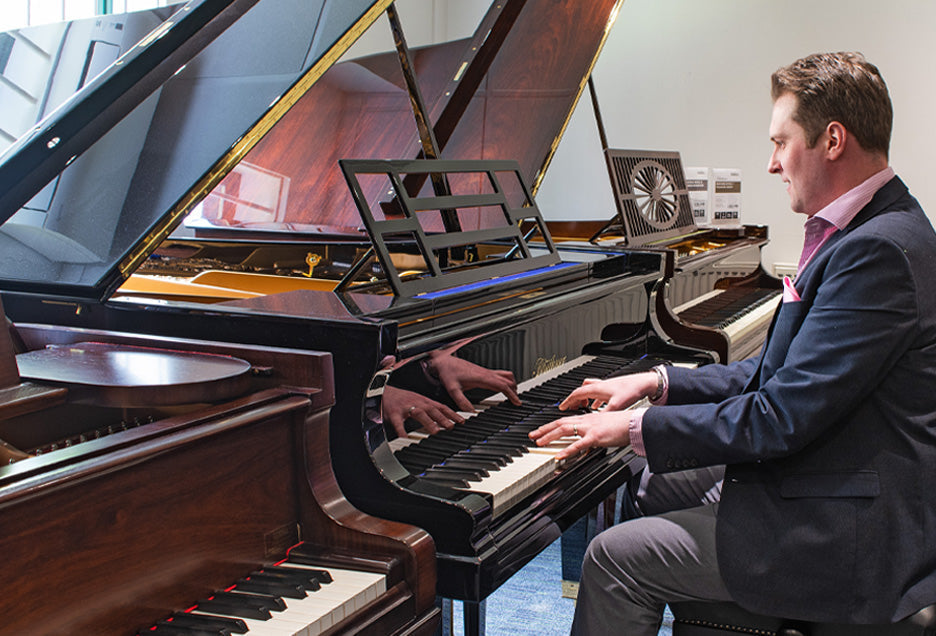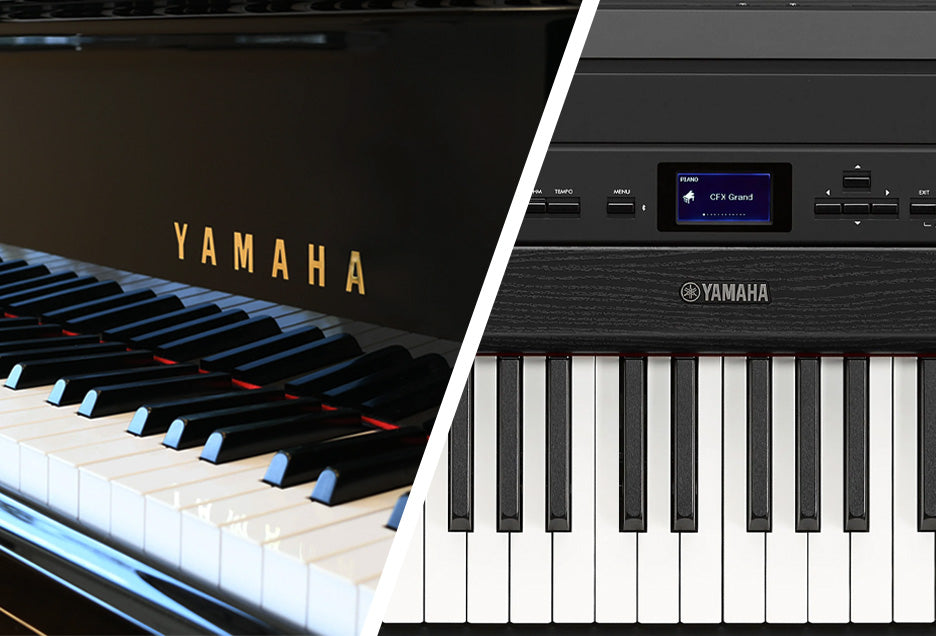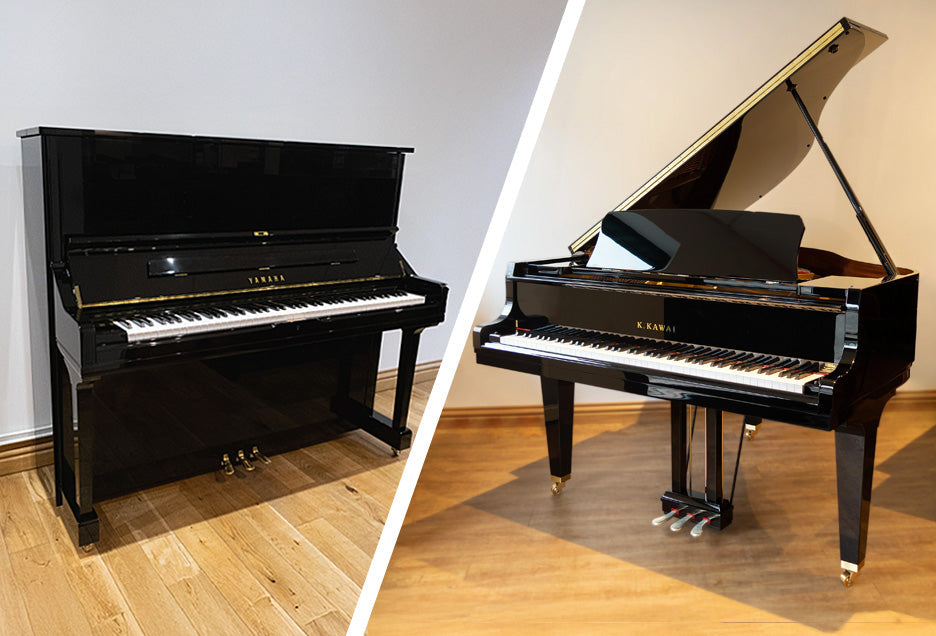Are they different?
The U Series is very much a cornerstone of Yamaha's upright piano offering, and very well regarded among teachers, technicians and pianists all over the world.
Much like comparing long established models of car, advances in design and manufacturing technology over time mean that a brand new or recent second hand piano is always better than one of a previous model generation.
In the case of the Yamaha U1 and U3, both of which have been in production since the early 1950's, an instrument that comes off the production line today is significantly more refined and ultimately more rewarding to play and hear than one which was made fifty or so years ago.
So what has changed?
A new U1 or U3 is constructed with improved quality component parts including under-felted hammers, with such useful features as a long music rest for large scores and a kitchen drawer style soft closing lid to prevent trapped fingers.
Advances in manufacturing techniques and technology mean that components can be machined to incredibly fine tolerances, with lumber for the soundboards and keyboards kiln dried to decimal point-specific levels of moisture content.
On a similar level, numerous refinements have been made to the action design to ensure a higher level of response, the number of wooden back-posts has been increased from four to five to provide enhanced stability, resonance and power, while the scale design has been refined to improve tonality and tuning.
Additionally, the latest generation U3 has what is called a 'floating' soundboard, a specially developed method of affixing the soundboard into the piano to allow it to resonate more freely.
What does reconditioning involve?
Yamaha approved reconditioned U Series pianos are exclusively reconditioned at the Yamaha Piano Services department in Hamamatsu Japan, where they are stripped down and rebuilt with all parts that wear out replaced.
These perishable components include: tapes, loop cords, butt springs, checking leathers, touch baizes, stringing felts, hammer felts, damper felts, key bushings, hammer and lever centres, and many more. All wood and metal components, including strings, are thoroughly cleaned, with the key surfaces replaced, a practice pedal installed if the piano doesn't already have one, before the casework is modernised with a new polished ebony finish and inlaid brass Yamaha logo.
The quality of workmanship on these instruments is superb, and on arrival at our Haslemere showroom and workshop our technician carries out a bespoke setup on each piano to ensure optimum performance and tonal quality. Each piano is supplied with a five-year Yamaha-backed warranty for your peace of mind, along with a certificate of authenticity.
If it's simply not as good, then why buy a reconditioned piano?
The answer to this is simple - these are incredibly good value for money!
A reconditioned U Series upright is approximately half the price of a brand new one, so consequently these instruments make for a very compelling choice.
While not as technically advanced or luxurious as a new U1Q or U3SQ model, a reconditioned U1H or U3H from the 1970's or 1980's is nevertheless a remarkably well engineered instrument - robust, reliable and certain to provide many more years of reliable service.
When comparing pianos at a similar price point, a reconditioned Yamaha U Series upright makes great financial sense. Most new pianos at this price point are smaller and less resonant, while there is certainly something to be said for the inherent build quality of a Japanese-built Yamaha piano.
What about the Yamaha B3?
Today Yamaha produces four acoustic upright piano models on the same 121cm tall frame - the ever popular U1, the semi-hand-crafted YUS1, the formerly British-made P121, and the b3.
The b3 sits at the top of the b Series, positioned in the market to compete with the Kawai K-300 and worth considering as a new, alternative option to a reconditioned U1. The piano is produced at Yamaha’s Indonesian factory to keep the cost competitive, and is essentially a ‘cut down’ version of a new Japanese built U1Q, sharing the same frame and hammers, along with the same five-piece back-post configuration to deliver a similar level of stability, resonance and power.
How is it different to a U1?
While the two pianos are the same size there are some key differences, after all the b3 is much cheaper than the U1.
Firstly, the b3 is made in Indonesia, while the U1 is and has always been made at the main manufacturing facility in Hamamatsu, Japan. Manufacturing in Indonesia is much more cost effective, enabling Yamaha to keep the quality high and the price keen.
The factory in Jakarta was set up and staffed in 2008 by technicians from Yamaha Japan, and is today one of the most modern piano manufacturing facilities in the world. Other manufacturers have since followed suit, and Kawai also now produces their K-15, K-200 and K-300 uprights in Indonesia.
The spruce for the b3’s soundboard, while still a solid piece of spruce, is less mature than that of the U1 with fewer growth rings. This means that the piano isn’t quite as resonant or tonally as refined as the U1.
There are cosmetic differences too. The fallboard on a new U1 has a luxurious soft close mechanism, is made from a single curved piece and is lockable. The fallboard of the b3 however is much more rudimentary, made of two pieces with a hinge and without the lock or soft-close. The two piece top lid on a U1 enables the lid to be folded back to aid projection and provide easier access to the tuning pins, while the b3 has a single piece lid without the split hinge. These differences don’t have any bearing on the playability of the instrument, but merely help Yamaha keep the b3 as affordable as possible.
Should I buy a b3 or a reconditioned U1?
It is still widely believed that a Japanese-built Yamaha piano, even one that is now approaching 50 years old, is a better piano than a new b3. Japanese-built Yamaha uprights are incredibly well engineered and are reliable, robust workhorses that are capable of providing many years of reliable service, and it is this that has cemented them the leading instrument of choice for many an institution, piano teacher and enthusiastic amateur pianist the world over.
On one hand, a 50 year old soundboard has a certain maturity, affording the reconditioned Yamaha U1 a wonderful depth of tone. There is also the value for money aspect, indeed a new equivalent is double the price. On the other hand however, no matter how well reconditioned, it will always be an old piano of an old design, and ultimately have a shorter lifespan than a new b3.
Today's b3 is an instrument born from many years of research and development, and there is no escaping the fact that a modern Yamaha piano is considerably more refined than one which came off the production line in Hamamatsu nearly 50 years ago. There is a certain safety in buying something that is brand new, factory fresh and exactly as the manufacturer intended, regardless of the factory in which it was produced.
The b3 is a very well thought out and well engineered instrument, indeed its very purpose is to be a great value alternative to the new Japanese-built U1, and this it achieves perfectly. It is also worth considering that a new b3 is also available as a hybrid piano, factory fitted with Yamaha's SC3 Silent system and also with the revolutionary new TC3 TransAcoustic system. These systems perfectly integrate acoustic and digital piano technologies, enabling the pianist to play privately or quietly at unsociable hours, record their performances and also use their piano as a music production tool through MIDI connectivity.
We always have a selection of new, reconditioned and second hand Yamaha U and B Series upright pianos in stock, on display and ready for selection. Schedule an appointment to choose your new, second hand or reconditioned Yamaha upright piano today.




